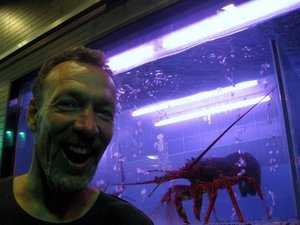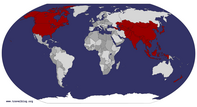Advertisement
Published: January 6th 2009

 ratanakiri!
ratanakiri!
a smile on every face at the Golden Cattle Seafood Restaurant!After two full months on the move, we are starting to experience serious travelers’ fatigue. When a purported five-hour boat ride turning into ten hours parked next to the open engine fumes no longer seems charming but simply migraine-inducing, when at the end of each day the dust which coats your clothing, shoes and skin could house an entire termite colony, when facing incessant swarm of taxi drivers, their mindless, parrot-like refrain “Tuk-Tuk? Tuk-Tuk, Laay-Dee?? Sir, Tuk-Tuk?” requires gulping restraint to suppress hell-hath-no -fury-Sean Penn-swings-at-tabloid-hordes rage, it’s time for a break. Feeling apathy toward all things touristy, we decided to high-tail it from Battambong to the small southern town of Kampot as quickly as possible, and then hastily trip down to the southern Thai islands. When we stepped off the bus in Phnom Penh, we aimed to board the next immediate departure for Kampot. Other travelers we spoke to were quick to dismiss Phnom Penh, recommending we avoid it entirely. ‘Worst capital city in Asia’, they groused, citing ‘serious gun problems’ and other such unpalatable reviews. We jockeyed our way around predatory tuk-tuk drivers to the bus schedule, painted on a large, plywood plank. The last bus to Kampot left two
hours ago. I swallowed hard, preparing to face the Compton of Southeast Asia with no Khmer and a hulking, tangerine backpack all but screaming “Rob me!!” One night. We’d be fine.
We called upon the least pushy tuk-tuk driver to ferry us to a guesthouse. Narrow streets gorged with food stalls and motos open onto broad boulevards lined with frangipani and tall palms. The warm air is modulated by sudden gusts of temperate air, and buildings are tall and stately. Our guesthouse is a five-story Miami-festive purple number; our room spotlessly tiled, with white molding, a hot water shower, real wood furniture, and one hundred channels of cable television. The lawless, open-sewered, gun-totin’ dystopia of travel lore is nowhere to be seen. We ditch our stuff and wander to the Sorya Shopping Center, a multi-escalatored tower of glass and merchandise worthy of Logan’s Run, and a sweet elixir to the last week of dust. 7-11s and malls, haunts that might evoke apathy, boredom, or outright distaste at home, have morphed into oases of gleaming surfaces and clearly marked pricing. We skip into the luscious A/C and marvel and point like children at the zoo- “Yogurt!” “Cheese?!” Still slightly leery
of the city after dark, we spend New Year’s Eve sprawled on white sheets, eating strawberry yogurt and (40 cent!) chocolate croissants and watching episode after episode of 30 ROCK. Phnom Penh might not be so bad after all. In fact, the city we were so set on avoiding is spoiling us rotten. Her timing couldn’t have been better.
New Year’s morning is blue skies and breeze, moto traffic and swollen sidewalks. No one, except for us, seems to walk in this city, and in the absence of pedestrians, sidewalks are colonized by magazine and fruit stalls, SUVs resting their pachydermal bulk, and small herds of black garbage bags. We sit down at an open air restaurant for café au lait, what the Khmers call their thick, dark coffee sweetened with heavy dollops of condensed milk. The owner, a broad-faced balding man with a wide smile and crinkling eyes, sits down with us. We order beef noodle soup (normal Cambodian breakfast fare) and soon we are deep in Khmer language lessons. Sovann is 53 years old (Typical Khmer first meeting questions—“How old are you??” “How many babies you have?”) and like most Cambodians, speaks pretty good English. He is

 New Year's Dinner!
New Year's Dinner!
The best 'mall' food we've ever tasted: Beef LukLak for $1.50! a lieutenant colonel in the Cambodian Air Force, but also runs this soup shop with his family. His eldest son, who works for the Ministry of Finance, also waits tables each morning before heading off to his office job. They are both at the shop all day today, along with the rest of their extended family, because it is a national holiday. Sovann commandeers our ripped-out Lonely Planet language section, surveys the Khmer phrases and leads us step-by-step through the diabolical k’d and ch’th constructions. We work together for over an hour. Sovann is generous with his time and seems genuinely happy to help us and to discuss the differences in our languages. Our soup never comes, and only at the end of our time together does Sovann explain that the soup pot was empty prior to our arrival, which is why he asked , “What would you like to drink?” When we still proceeded to order soup, he had smiled and nodded, because it would have been rude to tell us no. But, he explains, his introductory question was essentially letting us know they were out of soup. I can’t imagine how many subtle messages of this sort we
miss every day. Sovann wishes us long life and good fortune and we return his sweet sentiments.
We walk a few blocks further, skirting a Cambodian wedding tent set up in the middle of the street, flapping lurid satin over a booming live band, just outside the barbed wire of Toul Sleng Genocide Museum, located on the former grounds of the Khmer Rouge Security Prison 21. In 1962, the compound was a high school called Ponhea Yat after a royal ancestor of King Norodom Sihanouk. The location is also known as Toul Sleng. In Khmer, ‘toul’ is a noun meaning ground higher than that around it. ‘Sleng’ can function as an adjective, meaning either ‘supplying guilt’ or ‘bearing poison’. Thus, ‘toul sleng’ can either be translated as a poisonous hill, or a mound on which exists those who bear or supply guilt. The Khmer Rouge seized the school and the classrooms were divided into small cells, 6’ x 4’, designed for single prisoners. Larger rooms were used for mass prison cells and interrogation rooms. During the years of 1975-1978, it is estimated that about 20,000 prisoners were held at S-21. The majority of prisoners were Cambodian, however, the Khmer

 S-21
S-21
Toul Sleng Genocide MuseumRouge also imprisoned and killed Vietnamese, Laotians, Thai, Indians, British, Pakistanis, Americans, Canadians, New Zealanders, and Australians. Under Pol Pot’s charismatic leadership, the Khmer Rouge surged into Phnom Penh , ‘liberating’ the city from the grasp of the arguably equally oppressive Lon Nol. The KR evacuated the city, moving ‘new people’ to the country for agrarian reeducation, and targeted doctors, professors, engineers, technicians, students, people with glasses-anyone deemed an intellectual or a skilled worker, as enemies of the Khmer Rouge and Democratic Kampuchea. Whole families, including babies, were brought to S-21 to be tortured and subsequently murdered. Out of 15,000, seven people survived imprisonment at S-21.
Khmer Rouge soldiers had already fled when Vietnamese soldiers reclaimed the compound in late 1978, leaving behind the corpses of fourteen recently deceased prisoners, skeletal bodies on left on bed frames, or on the floor in a pool of blood, still shackled to the walls with iron bars. These corpses were photographed, and with the exception of the removal of the bodies, the rooms have been left just as they were, a photograph on the wall of the cell displaying the bodies as they were discovered. Solitary rusted bed frames and U.S. munitions
boxes sit haphazardly deserted amid peeling paint and blood-darkened tiles. The breeze whips through the heavy, empty rooms and out between the iron bars of the back windows. Peeling shutters bang noisily against the concrete, unsettled by something in the air.
Subsequent rooms house hundreds of portraits of victims of S-21 taken by the Khmer Rouge as prisoners were processed: men, women, children and babies. Their expressions at this moment reveal something of their personalities—do they approach this moment with fear, scorn, pride, anxiety, contrition, peace? Exhumed skulls are on display, featuring gaping holes from bludgeoning- the KR used blunt force, tree trunks, etc. to kill so as to not waste bullets. The museum also houses the Khmer Rouge’s instruments of torture- water boarding boxes, tables designed for finger nail removal, and a host of simple farming tools- spades, rakes, scythes and axes. It is the mundane nature of parts of the compound- the quotidian tools made torture implements, the manicured school grounds complete with magnolia and palm trees, the school pull-up bar-cum-gallows - that feels the most chilling: the collision of routine with the unthinkable, the range of our own potential.
Mass graves are still being

 Prisoners' cells
Prisoners' cells
Converted classroomsdiscovered, but most estimate that between 1975 and 1978, Pol Pot oversaw the massacre of over one million of his own people. Walking back from S-21, we glance at a woman riding by on a bicycles and feel that we’ve somehow trespassed. It feels perverse, improper, that we know something so intensely personal and brutally ugly about her life, just because she is over forty. This is true of Sovann, and so many others here. Life feels so normal here now; it is so hard to imagine the sick rot beneath the white magnolias. I suppose it is partially for that reason, that Cambodians are recovering, that Phnom Penh does feel normal, that it is so important that Tuol Sleng remains the ghost on this poisoned hill, soothed by the footfalls of visitors and persistent anthems of new love.
Although most Cambodians view Pol Pot negatively, they do not wholeheartedly denounce the Khmer Rouge. Pol Pot’s army was largely comprised of forced conscriptions who enlisted only to save their own lives. The political haze is further obfuscated by the fact that Pol Pot initiated attacks into Vietnam, asserting that the Vietnamese were attempting to occupy mother Kampuchea (a decision
that would ultimately secure the KR’s ‘official’ defeat in 1978). Pot’s infectious propaganda stirred a fervent patriotism, and a deep suspicion of the Vietnamese forces that eventually liberated Cambodia. This cynicism regarding Vietnamese interests in Cambodia lingers, and thus former Khmer Rouge soldiers are also regarded as patriots for their defense of the homeland. Interestingly, because Toul Sleng was established with Vietnamese help, many skeptical Cambodians initially believed the museum’s figures were inaccurate and sensationalized.
The Khmer Rouge’s purge of any skilled laborers had catastrophic effects on the Cambodian economy, but there has been a huge surge in population born since 1979. Over 50% of Cambodia’s population is under 18. It is hard to imagine this city emptied of its residents just thirty years ago. Phnom Penh pulses with life. Its streets, mostly devoid of traffic lights or rules, function with a fluid anarchy: oncoming cars, trucks, buses, cyclos, motos, and bicycles all jostle together, turning in front of one another with no shift in confidence, near-missing with a learned, reckless grace.
Advertisement
Tot: 0.127s; Tpl: 0.014s; cc: 8; qc: 51; dbt: 0.0693s; 1; m:domysql w:travelblog (10.17.0.13); sld: 1;
; mem: 1.2mb
























Elizabeth
non-member comment
Still loving it
Thanks for another great read. Sobering, surprising, sad, wonderful. Happy New Year. 30 Rock rocks -- way better than watching Dick Clark and the Times Square Ball dropping. May 09 be the best ever.